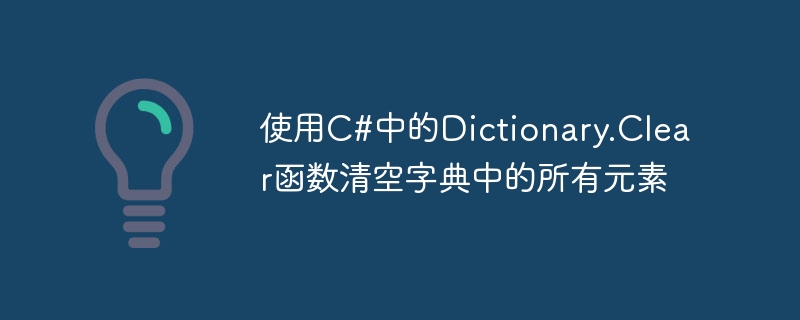 Backend Development
Backend Development
 C#.Net Tutorial
C#.Net Tutorial
 Clear all elements in a dictionary using Dictionary.Clear function in C#
Clear all elements in a dictionary using Dictionary.Clear function in C#
Clear all elements in a dictionary using Dictionary.Clear function in C#

Use the Dictionary.Clear function in C# to clear all elements in the dictionary
Dictionary (dictionary) is one of the commonly used data structures in C#. When it comes to data processing and storage, dictionaries provide a fast and efficient way to find, insert, and delete elements. The Dictionary class in C# is a generic class that uses key-value pairs to store data.
In actual development, we often need to clear all elements in the dictionary in order to perform data operations again. The Dictionary class in C# provides an effective function Clear to achieve this purpose. The following will introduce in detail how to use the Dictionary.Clear function in C# to clear all elements in the dictionary, with specific code examples.
First, we need to create a Dictionary object and add some elements to it for emptying.
using System;
using System.Collections.Generic;
class Program
{
static void Main()
{
// 创建一个Dictionary对象
Dictionary<int, string> myDictionary = new Dictionary<int, string>();
// 向字典中添加元素
myDictionary.Add(1, "Apple");
myDictionary.Add(2, "Banana");
myDictionary.Add(3, "Orange");
myDictionary.Add(4, "Grapes");
// 输出字典中的元素(在清空之前)
Console.WriteLine("Dictionary before clear:");
foreach (var item in myDictionary)
{
Console.WriteLine("Key: {0}, Value: {1}", item.Key, item.Value);
}
Console.WriteLine();
// 使用Clear函数清空字典
myDictionary.Clear();
// 输出字典中的元素(在清空之后)
Console.WriteLine("Dictionary after clear:");
foreach (var item in myDictionary)
{
Console.WriteLine("Key: {0}, Value: {1}", item.Key, item.Value);
}
}
}Running the above code, we can observe the following output:
Dictionary before clear: Key: 1, Value: Apple Key: 2, Value: Banana Key: 3, Value: Orange Key: 4, Value: Grapes Dictionary after clear:
As can be seen from the results, before calling the Clear function, the dictionary contains four key-value pairs. After calling the Clear function, there are no longer any elements in the dictionary.
The principle of using the Dictionary.Clear function to clear the dictionary is very simple. This function will directly remove all elements in the dictionary and set the Count property of the dictionary to 0.
In actual development, clearing the dictionary can provide us with a clean empty dictionary for re-operation of data. However, it should be noted that after clearing the dictionary, if you need to use the dictionary again, you need to re-add elements.
To summarize, by using the Dictionary.Clear function in C#, we can quickly and effectively clear all elements in the dictionary, providing a clean starting point for subsequent data processing. Mastering how to operate a dictionary will help improve the performance and efficiency of the program.
The above is the detailed content of Clear all elements in a dictionary using Dictionary.Clear function in C#. For more information, please follow other related articles on the PHP Chinese website!

Hot AI Tools

Undresser.AI Undress
AI-powered app for creating realistic nude photos

AI Clothes Remover
Online AI tool for removing clothes from photos.

Undress AI Tool
Undress images for free

Clothoff.io
AI clothes remover

Video Face Swap
Swap faces in any video effortlessly with our completely free AI face swap tool!

Hot Article

Hot Tools

Notepad++7.3.1
Easy-to-use and free code editor

SublimeText3 Chinese version
Chinese version, very easy to use

Zend Studio 13.0.1
Powerful PHP integrated development environment

Dreamweaver CS6
Visual web development tools

SublimeText3 Mac version
God-level code editing software (SublimeText3)

Hot Topics
 Active Directory with C#
Sep 03, 2024 pm 03:33 PM
Active Directory with C#
Sep 03, 2024 pm 03:33 PM
Guide to Active Directory with C#. Here we discuss the introduction and how Active Directory works in C# along with the syntax and example.
 C# Serialization
Sep 03, 2024 pm 03:30 PM
C# Serialization
Sep 03, 2024 pm 03:30 PM
Guide to C# Serialization. Here we discuss the introduction, steps of C# serialization object, working, and example respectively.
 Random Number Generator in C#
Sep 03, 2024 pm 03:34 PM
Random Number Generator in C#
Sep 03, 2024 pm 03:34 PM
Guide to Random Number Generator in C#. Here we discuss how Random Number Generator work, concept of pseudo-random and secure numbers.
 C# Data Grid View
Sep 03, 2024 pm 03:32 PM
C# Data Grid View
Sep 03, 2024 pm 03:32 PM
Guide to C# Data Grid View. Here we discuss the examples of how a data grid view can be loaded and exported from the SQL database or an excel file.
 Factorial in C#
Sep 03, 2024 pm 03:34 PM
Factorial in C#
Sep 03, 2024 pm 03:34 PM
Guide to Factorial in C#. Here we discuss the introduction to factorial in c# along with different examples and code implementation.
 Patterns in C#
Sep 03, 2024 pm 03:33 PM
Patterns in C#
Sep 03, 2024 pm 03:33 PM
Guide to Patterns in C#. Here we discuss the introduction and top 3 types of Patterns in C# along with its examples and code implementation.
 The difference between multithreading and asynchronous c#
Apr 03, 2025 pm 02:57 PM
The difference between multithreading and asynchronous c#
Apr 03, 2025 pm 02:57 PM
The difference between multithreading and asynchronous is that multithreading executes multiple threads at the same time, while asynchronously performs operations without blocking the current thread. Multithreading is used for compute-intensive tasks, while asynchronously is used for user interaction. The advantage of multi-threading is to improve computing performance, while the advantage of asynchronous is to not block UI threads. Choosing multithreading or asynchronous depends on the nature of the task: Computation-intensive tasks use multithreading, tasks that interact with external resources and need to keep UI responsiveness use asynchronous.
 Prime Numbers in C#
Sep 03, 2024 pm 03:35 PM
Prime Numbers in C#
Sep 03, 2024 pm 03:35 PM
Guide to Prime Numbers in C#. Here we discuss the introduction and examples of prime numbers in c# along with code implementation.





